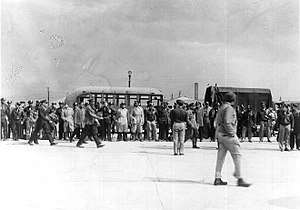Mitchell Higginbotham
Mitchell Higginbotham (March 2, 1921 – February 14, 2016) was a U.S. Army Air Force officer who was a member of the famed African American World War II fighter group known as the Tuskegee Airmen.[1][2]
Mitchell Higginbotham | |
|---|---|
| Born | March 2, 1921 |
| Died | February 14, 2016 (aged 94) |
| Nationality | American |
| Occupation | U.S. Army Air Force |
| Years active | 1942-1946 (active), 1946-1962 (reserve) |
| Known for | Tuskegee Airmen |
| Relatives | Robert Higginbotham (brother) |
| Awards | Congressional Gold Medal |
Biography
Early life
Higginbotham was born on March 2, 1921 [1] in Amherst, Virginia to Plinkam L Higginbotham and Hester Higginbotham.[3] He has a younger brother, Robert, who also became a member of the U.S. military.[4]
Military career
Higginbotham joined the U.S. military in the summer 1942.[1] He subsequently was accepted into the Tuskegee Army Airfield Class TE-44-K from which he graduated on February 1, 1945 with a commission as a Second Lieutenant.[1] Higginbotham became one of the original members of the Tuskegee Airmen when he was assigned to the 477th Bombardment Group.[1] He served on active duty through the end of World War II; in 1946, he left active duty but continued as a member of the U.S. Army Air Force Reserves.[1] He initially flew fighter aircraft but eventually moved up to flying B-52s.[4]
Higginbotham's younger brother Robert also joined the military during World War II two years after his older brother; however, Robert Higginbotham became a pilot for the Navy Air Corps.[4]

Higginbotham was one of 100 black servicemen who were arrested for attempting to enter an officers club reserved for white officers.[4] This event became known as the Freeman Field Mutiny;[4] it is widely seen as a key moment in the path towards full integration of the U.S. Armed Services.[5]
Awards
Higginbotham and his brother Robert both attended the ceremony in 2007 where the Congressional Gold Medal was collectively awarded to the Tuskegee Airmen for their contributions during World War II.[4] He also received "Man of the Year" Award from the Los Angeles Chapter of the Tuskegee Airmen, Inc in 1996.[1]
See also
- 477th Bomber Group
- Freeman Field Mutiny
- Tuskegee Airmen
Further reading
Articles
- Thomas-Lester, Avis (August 4, 2011). "Tuskegee Airmen's ranks may be smaller, but these veterans are still flying high". Washington Post. Retrieved 27 November 2013.
Archival resources
- Mitchell Higginbotham Papers (6.25 linear feet) are housed in the Special Collections & Archives of the University of California, Riverside Libraries.
References
- "Guide to the Mitchell Higginbotham Papers". Regents of the University of California. Retrieved 27 November 2013.
- "Tuskegee Airman of Rancho Mirage dies at 94". The Desert Sun. 16 February 2016. Retrieved 18 February 2016.
- 1930 Federal Census
- "Tuskegee Airman from Sewickley reflects on obstacles". Trib Total Media, Inc. Retrieved 27 November 2013.
- Francis, Charles E. (1997). Adolph Caso (ed.). The Tuskegee airmen : the men who changed a nation (4th ed.). Boston: Branden. pp. 231–255. ISBN 9780828320290.
External links
- Los Angeles Chapter, Tuskegee Airmen, Inc.
- Tuskegee Airmen at Tuskegee University
- Tuskegee Airmen Archives at the University of California, Riverside Libraries.
- Tuskegee Airman from Sewickley reflects on obstacles
- Tuskegee Airmen, Inc.
- Tuskegee Airmen National Historic Site (U.S. National Park Service)
- Tuskegee Airmen National Museum
